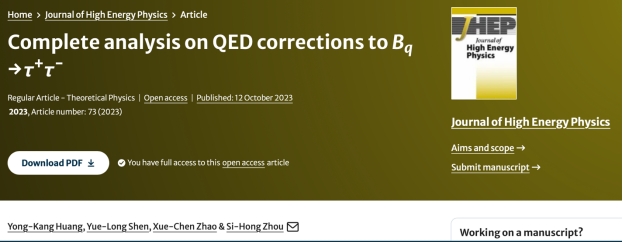Recently, Journal of Energy Physics(JHEP), an international top journal for energy physics and Nature-Index journal, has published the article titled “Complete analysis on QED corrections to Bq→ τ+ τ−” which is jointly completed with Associate Prof. Zhou Sihong of the School of Physical Science and Technology(SPST) of IMU as one of the corresponding authors. JHEP is jointly issued and published by SISSA and Springer and its latest effect factor is 6.379. The journal is listed in the First Section of Chinese Academy of Sciences indexed journals. The article has fully calculated, for the first time in the world, the QED effect in the purely leptonic decays of B mesons under the soft collinear effective theory(SCET). URL of the article is https://link.springer.com/article/10.1007/JHEP10(2023)073.

The purely leptonic decays of heavy B mesons are highly suppressed in the standard model (SM) due to the loop suppresses (FCNC) and helicity suppresses. Therefore, they have an important role in the accurate test of SM and finding out new physical effect beyond the Standard Model (BSM). With higher and higher measurement accuracy of the decays of B mesons in such experiments as Belle II and LHCb, the theoretical accuracy for the corresponding processes should be improved. The theoretical calculation of the decays of B mesons involves low-scaling QCD effect, which makes it hard to conduct theoretical calculation. Theoretically, the calculation concerned can be conducted with nonperturbative calculation approaches such as lattice QCD and light cone sum rules or effective theory such as SCET. Of the channels for B meson decays, the purely leptonic decays of B mesons is comparatively pure and do not involve too many sophisticated QCD effects in comparison with non-leptonic decays. As a result, the author chose to calculate the DED effect in the purely leptonic decays of B mesons to avoid the complicated QCD effects.
The article applies SCET to calculate the QED corrections in the purely leptonic decays of B mesons. In around 2001, SCET was proposed to solve the problem that the final state of heavy B meson decays involves the movement with huge dynamics and has been later widely applied in the processes of high energy colliders. In the purely leptonic decays of B mesons that is studied in the article, the final-state particle of τ+ τ− rapidly moves back to back in a certain direction in the rest system, which involves many scales including hard scale, hard-collinear scale, collinear scale, soft scale and soft-collinear scale. The article uses the two-step matching of SCET to respectively calculate hard function and hard-collinear function. Finally, the soft function and soft-collinear function in convolution derive complete factorized equation of high-order QED corrections. It is worth mentioning that in the regular high-order power correction calculation hard function will have endpoint divergency when it convolutes hard-collinear function, which will directly lead to the factorization failure. However, Bq→ τ+ τ− that is studied in the article does not have endpoint divergency because its final states are the particles of hard-collinear scale, hence no abnormal factorization. In the article, the branching ratio, the observed quantity in the experiment, was calculated and high-order QED effect will change 0.4% of the original result, which is expected to be tested in the future high-precision experiments.
The ordering of the authors of an article in the field of high energy physics often follows the international conventions for high-energy physics, i.e. in the alphabetic order. The ordering of the article authors is Huang Yongkang, a postgraduate student with Nankai University, Prof. Shen Yuelong with Ocean University of China, Zhao Xuechen, a postgraduate student with Nankai University and Associate Prof. Zhou Sihong with Inner Mongolia University who is the corresponding author of the article. The work is supported by the National Natural Science Foundation of China( Grant No.12105148).

